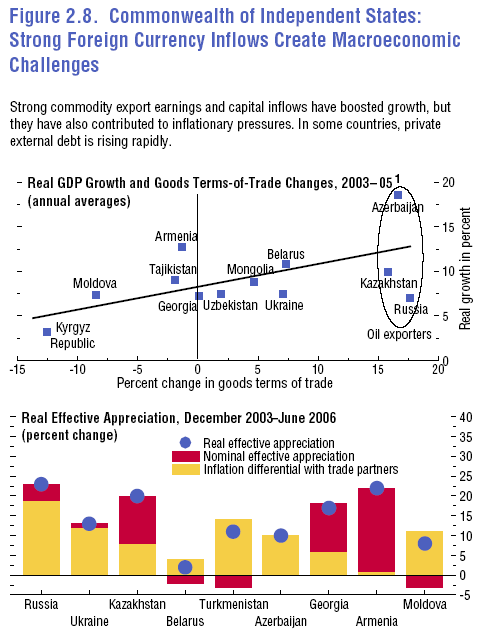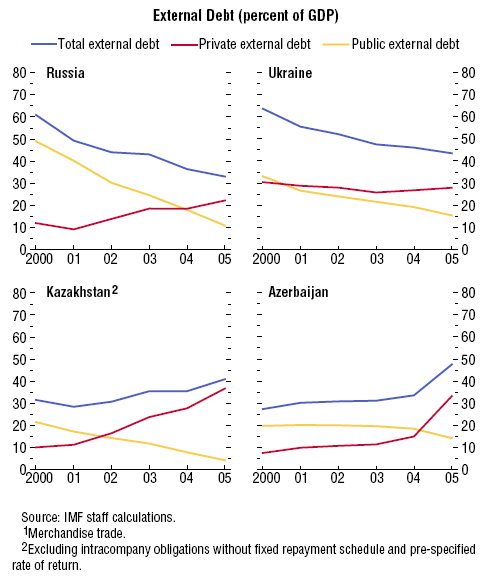|
Commonwealth of Independent States:
Managing Large Foreign Currency Inflows
Real GDP growth in the
Commonwealth of Independent States (CIS) is on course to reach close to 7
percent in 2006, before easing to about 6.5
percent in 2007
(Table 2.6). The region continues to benefit from high commodity prices and
correspondingly strong export earnings (Figure 2.8).
|
Table
2.6. Commonwealth of Independent States: Real GDP, Consumer Prices, and
|
|
|
Current Account Balance |
|
|
(Annual
percent change unless noted otherwise) |
|
|
|
Real
GDP |
|
|
Consumer Prices1 |
|
Current
Account Balance2 |
|
|
______ |
______________ |
______ |
_____ |
________________ |
_____ |
____________________________ |
|
|
2004 |
2005 2006
|
2007 |
2004 |
2005 2006 |
2007 |
2004 2005 2006 2007 |
|
|
Commonwealth of
|
|
|
|
|
|
|
|
|
|
|
|
|
|
Independent States
|
8.4 |
6.5 |
6.8 |
6.5 |
10.3 |
12.3 |
9.6 |
9.3 |
8.1 |
8.8 |
10.1 |
9.4 |
|
Russia |
7.2 |
6.4 |
6.5 |
6.5 |
10.9 |
12.6 |
9.7 |
8.5 |
9.9 |
10.9 |
12.3 |
10.7 |
|
Ukraine
|
12.1 |
2.6 |
5.0 |
2.8 |
9.0 |
13.5 |
9.3 |
13.5 |
10.6 |
3.1 |
–2.2 |
–3.8 |
|
Kazakhstan |
9.6 |
9.4 |
8.3 |
7.7 |
6.9 |
7.6 |
8.5 |
7.9 |
1.1 |
–0.9 |
2.3 |
2.1 |
|
Belarus |
11.4 |
9.3 |
7.0 |
4.5 |
18.1 |
10.3 |
7.9 |
9.0 |
–5.2 |
1.6 |
0.2 |
–1.1 |
|
Turkmenistan
|
14.7 |
9.6 |
9.0 |
9.0 |
5.9 |
10.7 |
9.0 |
8.0 |
0.6 |
5.1 |
7.6 |
8.0 |
|
Low-income CIS
countries |
8.5 |
11.9 |
12.5 |
13.2 |
7.5 |
11.9 |
11.4 |
9.8 |
–7.0 |
1.7 |
10.2 |
21.1 |
|
Armenia
|
10.1 |
13.9 |
7.5 |
6.0 |
7.0 |
0.6 |
3.0 |
3.0 |
–4.6 |
–3.3 |
–4.4 |
–4.6 |
|
Azerbaijan |
10.2 |
24.3 |
25.6 |
26.4 |
6.7 |
9.7 |
8.7 |
10.5 |
–29.8 |
1.3 |
26.0 |
44.8 |
|
Georgia |
5.9 |
9.3 |
7.5 |
6.5 |
5.7 |
8.3 |
9.6 |
6.0 |
–8.4 |
–5.4 |
–9.9 |
–11.5 |
|
Kyrgyz republic
|
7.0 |
–0.6 |
5.0 |
5.5 |
4.1 |
4.3 |
5.7 |
4.5 |
–3.4 |
–8.1 |
–7.9 |
–7.7 |
|
Moldova |
7.4 |
7.1 |
3.0 |
3.0 |
12.5 |
11.9 |
11.5 |
10.5 |
–2.0 |
–8.3 |
–10.5 |
–6.8 |
|
Tajikistan
|
10.6 |
6.7 |
8.0 |
6.0 |
7.1 |
7.1 |
7.8 |
5.0 |
–4.0 |
–3.4 |
–4.2 |
–4.8 |
|
Uzbekistan
|
7.7 |
7.0 |
7.2 |
7.0 |
8.8 |
21.0 |
19.3 |
14.5 |
10.0 |
13.1 |
12.0 |
11.9 |
|
Memorandum
|
|
|
|
|
|
|
|
|
|
|
|
|
|
Net energy exporters3
|
7.6 |
7.1 |
7.2 |
7.3 |
10.4 |
12.4 |
9.8 |
8.6 |
8.7 |
10.0 |
11.8 |
11.0 |
|
Net energy importers4
|
11.5 |
4.3 |
5.5 |
3.4 |
10.2 |
12.0 |
8.8 |
11.8 |
4.8 |
1.5 |
–2.4 |
–3.7 |
|
1in
accordance with standard practice in the World Economic Outlook,
movements in consumer prices are indicated as annual averages
|
|
|
rather than as December/December
changes, as is the practice in some countries. |
|
|
2Percent
of GDP. |
|
|
3includes
Azerbaijan, Kazakhstan, Russia, Turkmenistan, and Uzbekistan.
|
|
|
4includes
Armenia, Belarus, Georgia, Kyrgyz Republic, Moldova, Tajikistan, and
Ukraine. |
|


In several countries,
domestic demand has received an additional boost from substantial private
capital inflows (Russia, Kazakhstan), official financing (Georgia), and/or
remittances (Armenia, Georgia, Kyrgyz Republic, Moldova, Tajikistan).
Investment is recovering, including in Russia, where the impact of factors
responsible for the slowdown in 2004–05—including banking sector turbulences
and a tax-induced decline in oil sector profitability—is waning. Short-term
growth prospects are generally positive, although they remain heavily
dependent on commodity price developments. In the Ukraine, growth picked up
quite strongly in the first half of 2006, but the outlook remains clouded by
a projected deterioration in the terms of trade—due to the repricing of gas
imports from Russia and a possible reversal in the export price of steel—and
lingering policy uncertainties (at present, the Russian
energy company Gazprom charges between $47 (Belarus) and $160 (Moldova) for
1000 cubic meters of natural gas. This compares to a price of $230 per 1000
cubic meters for customers in western Europe. Gazprom increased export
prices to some CIS customers earlier this year, and has announced its
intention to bring prices even more closely in line with “market valuations”).
The
favorable external environment has created important challenges for
macroeconomic management, however, that need to be addressed with some
urgency to boost longer term growth prospects. High commodity prices have
relaxed short-term fiscal policy constraints, both directly—by increasing
export tax revenues and the profits of state-owned enterprises—and
indirectly by boosting aggregate demand, and thereby receipts from
consumption and income taxes. Often policymakers have used these extra funds
prudently, including to pay down public debt and/or to build up foreign
currency reserve cushions. More recently, however, some governments have
granted large pension and wage increases (Azerbaijan, Belarus, Kyrgyz
Republic, Tajikistan), which have further boosted consumption, undermined
competitiveness, and would be hard to reverse should the commodity price
cycle turn. Policymakers should not assume that recent revenue gains will
all be permanent (see Chapter 5). In countries where scope for fiscal easing
exists—such as in Russia, where there is room for some increase in public
spending without sacrificing sustainability, and in Kazakhstan—a more
expansionary stance should be accompanied by a reinvigoration of stalled
reforms to ensure that higher spending boosts investment and potential GDP
growth.
Monetary policy also faces important challenges. While inflation has
declined in recent months, it remains at or close to double-digit levels in
many countries, especially oil exporters. Further progress is needed, but
addressing disinflation is complicated by the focus of many central banks on
stabilizing the nominal exchange rate against the U.S. dollar in the face of
large current account surpluses and capital inflows. With the scope for
sterilization of foreign exchange purchases limited by underdeveloped
domestic debt markets, base money growth remains above levels consistent
with low, single-digit inflation rates. The danger is that inflationary
pressures may become entrenched, in which case costly measures may be
required in the future to reverse the inflation buildup. While early
repayment of external public debt or transfers into offshore oil funds (Azerbaijan,
Kazakhstan) can help to reduce base money growth, the most effective way to
lower inflation would be to allow for further nominal exchange rate
appreciation, thus enhancing the scope for monetary control aimed at
disinflation. In some energy-importing countries, inflationary pressures
could also emerge from the prospective repricing of fuel and gas imports, in
which case monetary policymakers will need to ensure that the necessary
pass-through of higher costs does not feed into core inflation, wages, and
inflation expectations.
The
commodity price boom has also complicated efforts to diversify production
and exports away from primary materials to goods with a higher value-added
component. Attracted by high expected export earnings, recent investments—
both domestic and foreign financed— have often focused on extractive
industries (Azerbaijan, Turkmenistan) or on commodity transport
infrastructure (oil and gas pipeline projects in Armenia, Azerbaijan,
Georgia, Kazakhstan). Moreover, the overall level of investment in the
region remains too low at 21 percent of GDP—the recent recovery
notwithstanding— which casts doubt on the sustainability of current growth
rates over the medium term. Structural reforms to improve the investment
climate are crucial to avoid the emergence or aggravation of supply
bottlenecks. In countries with large current account surpluses— notably
Russia—higher investment would also contribute to reducing global
macroeconomic imbalances.
External positions are strong in many countries in the region, especially
fuel exporters. For the region as a whole, a current account surplus of over
10 percent of GDP is projected for 2006. Large surpluses have permitted a
rapid reduction in the overall level of external debt in oil exporters,
especially by the public sector. In several countries (including Azerbaijan,
Kazakhstan, and Russia), however, the private sector has accumulated
substantial foreign currency liabilities in recent years (Figure 2.8), often
intermediated by the banking system. As a consequence, the private sector’s
vulnerability to a tightening in external financing conditions has increased.
Financial system soundness indicators have remained broadly stable, but this
is partly on account of the favorable macroeconomic environment. A
strengthening of prudential regulations and risk-based supervision would
help to reduce risks of financial instability in the face of a downturn, as
would measures to restrict regulatory forbearance and—in some cases—policies
to assure that the risks associated with the buildup of foreign currency
liabilities remain contained. |